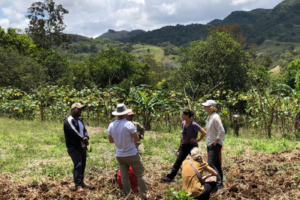
by ClausenCenter | Nov 25, 2024 | Grant, Research, Responsible Sourcing
by Alonso Alfaro-Ureña, Benjamin Faber, Cecile Gaubert, Isabela Manelici, Jose P. Vasquez||
Multinational enterprises (MNEs) increasingly impose “Responsible Sourcing” (RS) standards on their suppliers worldwide, including requirements on worker compensation, benefits and working conditions. Are these policies just “hot air” or do they impact exposed suppliers and their workers? What is the welfare incidence of RS in sourcing countries? To answer these questions, the authors developed a quantitative general equilibrium (GE) model of RS and combine it with a unique new database. In the theory, they show that the welfare implications of RS are ambiguous, depending on an interplay between what is akin to an export tax (+) and a labor market distortion (−). Empirically,they combine the near-universe of RS rollouts by MNE subsidiaries in Costa Rica since 2009 with firm-to-firm transactions and matched employeremployee microdata. They find that RS rollouts lead to significant reductions in firm sales and employment at exposed suppliers, an increase in their salaries to initially low-wage workers and a reduction in their low-wage employment share. We then use the estimated effects and the microdata to calibrate the model and quantify GE counterfactuals. They find that while MNE RS policies have led to significant gains among the roughly one third of low-wage workers employed at exposed suppliers ex ante, the majority of low-wage workers lose due to adverse indirect effects on their wages and the domestic price index.


by ClausenCenter | Nov 25, 2024 | by Barry Eichengreen, Grant, International Financial Architecture, Research
by Barry Eichengreen, My T. Nguyen, Ganesh Viswanath-Natraj
Stablecoins’ reliance on centralized custodians introduces devaluation risk similar to that of traditional currencies under fixed exchange rate regimes. The authoers construct market-based measures of stablecoin devaluation risk using spot and futures prices for Tether, estimating an average devaluation probability of 60 basis points annually and peaking at over 200 basis points during the 2022 Terra-Luna crash. Key risk factors include market volatility and transaction velocity, with elevated interest rates indicating devaluation risk. Deviations from covered interest rate parity point to segmentation between traditional and stablecoin markets, driven by leverage trading and arbitrage costs. Our findings suggest the need for increased transparency and regulatory oversight to mitigate stablecoin risk.


by ClausenCenter | May 7, 2019 | Brett Green & Catherine Wolfram, Grant, International Trade & Development, Research
by Paul Gertler, Brett Green, Catherine Wolfram
The proliferation of mobile technologies and digital payments systems have the potential to radically change the credit market landscape in developing economies. In this project we will explore how a combination of these recent advances have facilitated an innovative fi�nancial contract that utilizes a new form of collateral, which is designed to enhance technology adoption and access to collateralized borrowing the developing world. We will then explore the extent to which this collateral can be \re-used” to provide poor households with a�ordable and recurrent access to credit markets.


by ClausenCenter | May 7, 2019 | by Cecile Gaubert, Grant, International Trade & Development, Research
by Cecile Gaubert, Pat Kline and Danny Yagan.
Place-based redistribution is ubiquitous but has traditionally enjoyed little support among economists. We study a class of spatial equilibrium models highlighting the equity-efficiency tradeoffs that arise when taxes and transfers are indexed to location. Extending classic results on indirect taxation (Atkinson and Stiglitz 1976; Saez 2002), we establish conditions under which transfers from one region to another are welfare improving, even in the presence of an optimal place-blind income tax that already redistributes across worker types. The case for indexing transfers to place is strengthened when preferences for locations are heterogeneous across worker types, but it is dampened by heterogeneity in the productivity of locations. A calibration estimates the potential size of optimal place-based redistribution in the United States.


by ClausenCenter | May 6, 2019 | by Emi Nakamura and Jon Steinsson, Financial Globalization, Grant, Research
by Emi Nakamura and Jon Steinsson
There remains limited empirical evidence on the real consequences of fixed versus floating exchange rate regimes, despite the importance of the question, both in terms of developing open economy macroeconomics models, and in determining appropriate macroeconomic policies. A benchmark reference in this literature is Baxter and Stockman (1989), who conclude that the exchange rate arrangement doesn’t matter. This evidence is deeply unsatisfying. The main empirical exercise is to compare pre-1973 (fixed exchange rate) to 1973-1986 output volatility for a set of countries. However, many other factors changed between the pre and post period aside from the exchange rate regime, making it difficult to know whether the exchange rate regime was the cause of any difference between the two periods.
A more recent and more convincing reference is Broda (2006), who studies the effect of “terms of trade” shocks for countries with fixed versus floating exchange rates. A basic challenge here is that the terms of trade depend mechanically on the exchange rate. Broda focuses on small countries for whom he argues the terms of trade are exogenous. We can show, however, using our identification approach (more on this below) that the assumption of an exogenous terms of trade is violated. Rose (2011) concludes his recent survey on this topic by stating that “similar countries choose radically different exchange rate regimes without substantive consequences for macroeconomic outcomes like output growth and inflation.”
We believe these issues are ripe for re-investigation, given the limitations of the empirical methods that have been used in previous research. propose a new identification approach to study these issues below and present some preliminary results.


by ClausenCenter | May 6, 2019 | by Barry Eichengreen, Financial Globalization, Grant, Research
by Barry Eichengreen
There is no official Bank for International Settlements view of feasible and desirable exchange rate and international monetary arrangements, so far as can be gleaned from documents and publications of the institution. Butit is possible to discern the outlines of an unofficial, unstated institutional consensus. Its most prominent elements are the proposition that lax credit conditions create incentives for risk taking that can threaten systemic stability; that the instruments and institutions that convey capital flows across borders are important for understanding financial-stability risks; and that there is a role for macro-prudential policy in restraining the excesses that heighten these risks.
In this project I will trace the events, personalities and institutional dynamics responsible for the development of this view. I will do so through the lens of the Bank’s Annual Reports, which provide a distillation of the thinking of staff and management. I will see characterize the evolution of those analyses, focusing on the post-Bretton Woods period that saw the emergence of the modern BIS and is most directly relevant to today. I plan on supplementing my discussion with material from the BIS archives and secondary sources.













